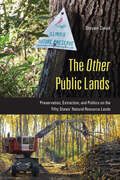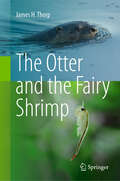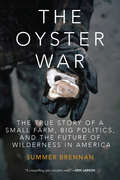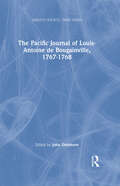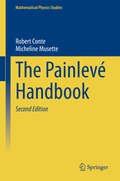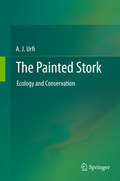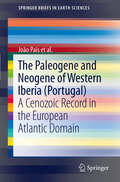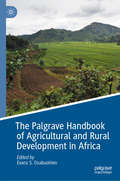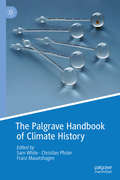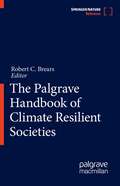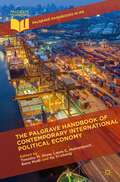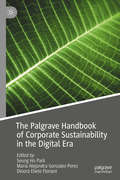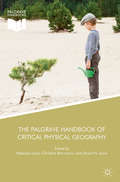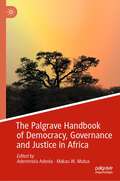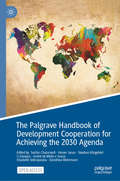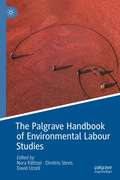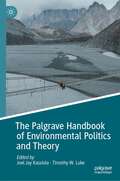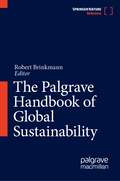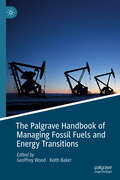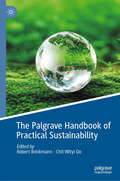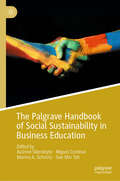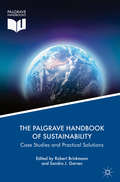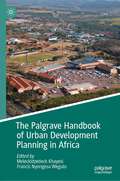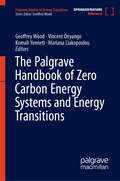- Table View
- List View
The Other Public Lands: Preservation, Extraction, and Politics on the Fifty States' Natural Resource Lands
by Steven DavisFor most Americans, state lands are the most readily accessible type of public land; however, despite their ubiquity, they remain largely terra incognita. The Other Public Lands is a primer on state public lands and the political dynamics that underlie their management. Offering a wide-angle overview, Steven Davis focuses on how states prioritize competing claims related to conservation, resource development, tourism, recreation, and finances. The Other Public Lands looks at both differences and common patterns in state land management, including the structure of natural resource agencies. Davis examines the privatization and commercialization of state parks, and the tensions between recreation, revenue and the preservation of biodiversity and natural landscapes. He also raises issues about equity, access, appropriate development, and ecological health. Chapters review state forests, state wildlife management areas, and school trust lands. In addition, the roles of interest groups, the courts, and agency culture and behavior are compared and analyzed both between states and the federal government and between states with differing approaches to specific issues. As there has been a demand to transfer at least some federal lands to the states, The Other Public Lands concludes with an appraisal of whether states could handle this transfer and goes on to suggest ways to ensure adequate access in an era of increased demand.
The Otter and the Fairy Shrimp
by James H. ThorpThis book presents information on common-to-rare organisms from around the world that inhabit freshwater habitats. The first six chapters focus on organisms from the very small (e.g., protozoa, zooplankton, and fairy shrimp) to the huge (e.g., hippos, freshwater sharks, and giant turtles), while the last four chapters provide information on aquatic ecosystems (lakes, streams, caves, and wetlands). Included in this last section are the physical nature of the system and how that influences the kinds of animals living there. This unique “nature” book, incorporating information from around the world on both aquatic systems and organisms, is written to attract the interest of a wide group of non-academic readers.
The Oyster War: The True Story of a Small Farm, Big Politics, and the Future of Wilderness in America
by Summer BrennanIt all began simply enough. In 1976 the Point Reyes Wilderness Act was passed with broad support, giving more than 33,000 acres of forest, grassland and shoreline the highest possible environmental protection in America. Those lands were to include a rare marine sanctuary, the Drakes Estuary, as "potential wilderness." Located in that estuary was a small, struggling oyster farm. In existence for more than eighty years, it was accused of doing environmental harm. In 2005 the farm was given notice by the National Parks Service that its lease on the property, due to expire in 2012, would not be renewed. The intention was to allow this area to be restored and to be a viable part of the wilderness preserve. Kevin Lunny, a local rancher, bought the oyster farm in 2005 and renamed it The Drakes Bay Oyster Company. He refused to acknowledge the term of the lease, nor did he intend to abide by it, and thus began a protracted battle in the courts and in the court of public opinion over the future of the estuary.Environmentalists, local activists, national politicians, scientists, and the Department of the Interior all joined the battle, which began as a matter of localbeginning. In a lyrical narrative style she explores the case, interviews and portrays the players, (major and minor), and presents this complex matter with thorough and deliberate care.
The Pacific Journal of Louis-Antoine de Bougainville, 1767-1768 (Hakluyt Society, Third Series #9)
by Louis-Antoine de BougainvilleThe French entered the Pacific in the late 17th century, but the ocean remained largely a Spanish preserve until British navigators began to cross its vast expanse in the mid 1760s. France's concerns that Britain might establish its superiority in the area, meant they welcomed Louis de Bougainville's voyage of exploration undertaken in 1766-9. After handing over the colony he had established in the Falkland Islands to Spain, he sailed through the still relatively unknown Straits of Magellan into the poorly charted South Pacific. He made a number of discoveries in the south west, but was too late to discover Tahiti, where Samuel Wallis had preceded him by less than a year. Reports on Bougainville's reception there and on life in the island were to create wide interest and controversy in Europe. He then sailed to the Samoan Islands and on to Vanuatu, as far as the Great Barrier Reef, and north towards New Guinea and the Samoan Islands making a number of discoveries and all the while leaving his name to a number of features, the best known of which are the island of Bougainville and the Bougainvillea flower. He returned home by way of the Dutch East Indies and the Indian Ocean. Although Bougainville published an account of his voyage in 1771, his original journal was published only in 1977; the present volume makes the latter text available for the first time in English translation.
The Painlevé Handbook (Mathematical Physics Studies)
by Robert Conte Micheline MusetteThis book, now in its second edition, introduces the singularity analysis of differential and difference equations via the Painlevé test and shows how Painlevé analysis provides a powerful algorithmic approach to building explicit solutions to nonlinear ordinary and partial differential equations. It is illustrated with integrable equations such as the nonlinear Schrödinger equation, the Korteweg-de Vries equation, Hénon-Heiles type Hamiltonians, and numerous physically relevant examples such as the Kuramoto-Sivashinsky equation, the Kolmogorov-Petrovski-Piskunov equation, and mainly the cubic and quintic Ginzburg-Landau equations. Extensively revised, updated, and expanded, this new edition includes: recent insights from Nevanlinna theory and analysis on both the cubic and quintic Ginzburg-Landau equations; a close look at physical problems involving the sixth Painlevé function; and an overview of new results since the book’s original publication with special focus on finite difference equations. The book features tutorials, appendices, and comprehensive references, and will appeal to graduate students and researchers in both mathematics and the physical sciences.
The Painted Stork
by A. J. UrfiThe book will cover the entire range of the Painted Stork--beyond its stronghold in India and Sri Lanka to other countries--E Asia as well. For the sake of comparison, relevant information will be included about the other species of storks--both solitary as well as colonial, of Asia, as well as those in other parts of the world. Certainly plenty of references will be made about the work done on the American Wood Stork. Studies are underway in order to better understand the role of the monsoon rains on the nesting pattern of Painted Stork, besides attempting a review of the global status of the species. The former is likely to be of interest in augmenting our understanding about how global climate change is going to affect birds across India and the second is likely to raise interesting points about the distribution of species and their ranges. Both these studies will be carried through 2009 and should hopefully be included in the proposed book. Naturally, the focused interest in field research on the Painted Stork has resulted in accumulation of considerable information on this particular species, which is beyond the information contained on some standard Indian and international works and ornithological texts. The author hopes to include the entire spread of information of this species--from its systematics, evolution, distribution, ecology to its role in human culture as well as its association with mythologies. In other words, topics have not been restricted to the areas of the author's research but have spilled over into areas of anthropology, ecology, conservation, etc.
The Paleogene and Neogene of Western Iberia (Portugal)
by João PaisThis volume includes a general description of the Portuguese Cenozoic basins in the Iberian tectonic context. The main stratigraphic units, including sedimentological, stratigraphical and palaeontological data, are characterized. Correlations between different sectors are presented as well as general paleogeographical evolution maps. The volume includes a general bibliography concerning the Cenozoic of Portugal.
The Palgrave Handbook of Agricultural and Rural Development in Africa
by Evans S. OsabuohienThis handbook examines agricultural and rural development in Africa from theoretical, empirical and policy stand points. It discusses the challenges of the United Nations Sustainable Development Goals (SDGs) and assesses how poverty and other development concerns can be addressed in rural communities through agricultural transformation. Additionally, the handbook extends the Post-2015 Development Agenda and it emphasizes the importance of the agricultural sector as it is closely related to the issues of food sustainability, poverty reduction, and employment creation. The contributors suggest multiple evidence-based policies to develop the rural areas through the transformation of the agricultural sector which can significantly benefit the African continent.
The Palgrave Handbook of Climate History
by Sam White Christian Pfister Franz MauelshagenThis handbook offers the first comprehensive, state-of-the-field guide to past weather and climate and their role in human societies. Bringing together dozens of international specialists from the sciences and humanities, this volume describes the methods, sources, and major findings of historical climate reconstruction and impact research. Its chapters take the reader through each key source of past climate and weather information and each technique of analysis; through each historical period and region of the world; through the major topics of climate and history and core case studies; and finally through the history of climate ideas and science. Using clear, non-technical language, The Palgrave Handbook of Climate History serves as a textbook for students, a reference guide for specialists and an introduction to climate history for scholars and interested readers.
The Palgrave Handbook of Climate Resilient Societies
by Robert C. BrearsThe effects of climate change are beginning to be felt around the world with rising temperatures, changing precipitation levels, more frequent and severe storms and longer more intensive droughts threatening human life and livelihoods and damaging property and infrastructure. As such, society in all countries – both developing and developed – need to increase their resilience to the impacts of climate change, where resilience is the ability of a system to absorb stresses and adapt in ways that improve the overall sustainability of the system; enabling it to be better prepared for future climate change impacts.In this context, a climate resilient society is one that is: reflective (learns from experiences); robust (both people and infrastructure can withstand the impacts of extreme conditions); forward-thinking (with plans made to ensure systems function during extreme events); flexible (so systems and plans can change, evolve or adopt alternative strategies); resourceful (to respond quickly to extreme events); inclusive (so all communities including the vulnerable are involved in planning); and integrated (so people, systems, decision-making and investments are mutually supportive of common goals).The Climate Resilient Societies Major Reference Work includes chapters covering a range of themes that provide readers with an invaluable overview on how various levels of government have attempted to create climate resilient societies. In particular, each chapter, under its respective theme, will address how a government, or series of governments, at various levels in non-OECD and/or OECD countries, have implemented innovative climate resilient policies that seek synergies across strategies, choices and actions, in an attempt to build a climate resilient society. Each chapter will address one specific sub-theme out of the population of themes covered in the Major Reference Work: Water, Energy, Agriculture and Food, Built environment and Infrastructure, Transport, Human health, Society, Disaster, Business and Economy, and Financing Climate Resilience.
The Palgrave Handbook of Contemporary International Political Economy (Palgrave Handbooks in IPE)
by Timothy M. Shaw Xu Yi-Chong Renu Modi Laura C. MahrenbachPublished 35 years after Palgrave Macmillan’s landmark International Political Economy (IPE) series was first founded, this Handbook captures the state of the art of contemporary IPE. It draws on the series’ history of focusing on the oft-neglected study of the global South.Providing interdisciplinary perspectives from scholars hailing from the global North and South, the Handbook illustrates the theoretical innovations and empirical richness necessary to explain today’s ever-changing world. This is a world in which the global South and North are not only being transformed by the end of bipolarity and the rise of the BRICS, but also by diverse global crises and growing cross-border challenges. It is a world where human development, governance and security are becoming ever more elusive, where, profoundly altered by the rise of new technologies, the structure of relations between nations itself is changing, becoming increasingly interconnected, both digitally and physically.Understanding these issues is of critical importance to better anticipate current and future global transformations. This Handbook is the ideal primer for all scholars, practitioners and policy makers looking to do so.
The Palgrave Handbook of Corporate Sustainability in the Digital Era
by Seung Ho Park Maria Alejandra Gonzalez-Perez Dinorá Eliete FlorianiThis handbook addresses the intersection between corporate sustainability and digital transformation. It analyzes the challenges and transformations required to be able to have sustainable businesses with a future orientation. Topics include current and potential social, demographic, technological, and managerial trends; the implications of the digital revolution in society and business; as well as the challenges of being sustainable, and profitable. Providing an understanding of the business reasons to incorporate a future orientation into the business strategy, this handbook facilitates an understanding of the need for profound changes in individual behavior, organizational culture, public policy, and business environments to adapt to the accelerated changes and manage business with orientation to the future.
The Palgrave Handbook of Critical Physical Geography
by Rebecca Lave Christine Biermann Stuart N. LaneThis handbook is recognition of the need to better integrate physical and human geography. It combines a collection of work and research within the new field of Critical Physical Geography, which gives critical attention to relations of social power with deep knowledge of a particular field of biophysical science. Critical Physical Geography research accords careful attention to biophysical landscapes and the power relations that have increasingly come to shape them, and to the politics of environmental science and the role of biophysical inquiry in promoting social and environmental justice. The Palgrave Handbook of Critical Physical Geography lays out the scope and guiding principles of Critical Physical Geography research. It presents a carefully selected set of empirical work, demonstrating the range and intellectual strength of existing integrative work in geography research. This handbook is the first of its kind to cover this emerging discipline and will be of significant interest to students and academics across the fields of geography, the environment and sustainability.
The Palgrave Handbook of Democracy, Governance and Justice in Africa
by Aderomola Adeola Makau W. MutuaThere is an emerging consensus that what is projected as democratic governance and justice in Africa requires a re-calibration, in particular, in relation to the constitutive demos, human rights, the realisation of commitments at various governance levels and the convergence between these ideations. The post-colonial narrative on democracy has unveiled some crevices in rule of law, political equality, political participation, political culture and freedom of the press. Aside from the fact that these notions are threatened by some existing institutional structures, these notions are increasingly being negotiated across political spaces. Evident in the prevalent narrative is an imperative for Africa to assert its place on the global scene of democratic governance and justice. However, if this will be accomplished, it is important to understand some of the issues that need to be worked through in this transition.
The Palgrave Handbook of Development Cooperation for Achieving the 2030 Agenda: Contested Collaboration
by Sachin Chaturvedi Stephan Klingebiel Dorothea Wehrmann Heiner Janus Xiaoyun Li André de Mello e Souza Elizabeth SidiropoulosThis open access handbook analyses the role of development cooperation in achieving the 2030 Agenda in a global context of ‘contested cooperation’. Development actors, including governments providing aid or South-South Cooperation, developing countries, and non-governmental actors (civil society, philanthropy, and businesses) constantly challenge underlying narratives and norms of development. The book explores how reconciling these differences fosters achievement of the Sustainable Development Goals.
The Palgrave Handbook of Environmental Labour Studies
by Nora Räthzel Dimitris Stevis David UzzellIn this comprehensive Handbook, scholars from across the globe explore the relationships between workers and nature in the context of the environmental crises. They provide an invaluable overview of a fast-growing research field that bridges the social and natural sciences. Chapters provide detailed perspectives of environmental labour studies, environmental struggles of workers, indigenous peoples, farmers and commoners in the Global South and North. The relations within and between organisations that hinder or promote environmental strategies are analysed, including the relations between workers and environmental organisations, NGOs, feminist and community movements.
The Palgrave Handbook of Environmental Politics and Theory (Environmental Politics and Theory)
by Timothy W. Luke Joel Jay KassiolaThis Handbook aims to provide a unique and convenient one-volume reference work, exhibiting the latest interdisciplinary explorations in this urgently burgeoning field of intellectual and practical importance. Due to its immense range and diversity, environmental politics and theory necessarily encompasses: empirical, normative, policy, political, organizational, and activist discussions unfolding across many disciplines. It is a challenge for its practitioners, let alone newcomers, to keep informed about the ongoing developments in this fast-changing area of study and to comprehend all of their implications. Through the planned volume’s extensive scope of contributions emphasizing environmental policy issues, normative prescriptions, and implementation strategies, the next generation of thinkers and activists will have very useful profiles of the theories, concepts, organizations, and movements central to environmental politics and theory. It is the editors’ aspiration that this volume will become a go-to resource on the myriad perspectives relevant to studying and improving the environment for advanced researchers as well as an introduction to new students seeking to understand the basic foundations and recommended resolutions to many of our environmental challenges. Environmental politics is more than theory alone, so the Handbook also considers theory-action connections by highlighting the past and current: thinkers, activists, social organizations, and movements that have worked to guide contemporary societies toward a more environmentally sustainable and just global order. Chapter “Eco-Anxiety and the Responses of Ecological Citizenship and Mindfulness” is available open access under a Creative Commons Attribution 4.0 International License via link.springer.com.
The Palgrave Handbook of Global Sustainability
by Robert BrinkmannThe field of sustainability continues to evolve as a discipline. The world is facing multiple sustainability challenges such as climate change, water depletion, ecosystem loss, and environmental racism. The Handbook of Sustainability will provide a comprehensive reference for the field that examines in depth the major themes within what are known as the three E’s of sustainability: environment, equity, and economics. These three themes will serve as the main organizing body of the work. In addition, the work will include sections on history and sustainability, major figures in the development of sustainability as a discipline, and important organizations that contributed or that continue to contribute to sustainability as a field. The work is explicitly global in scope as it considers the very different issues associated with sustainability in the global north and south
The Palgrave Handbook of Managing Fossil Fuels and Energy Transitions
by Keith Baker Geoffrey WoodThis Handbook is the first volume to comprehensively analyse and problem-solve how to manage the decline of fossil fuels as the world tackles climate change and shifts towards a low-carbon energy transition. The overall findings are straight-forward and unsurprising: although fossil fuels have powered the industrialisation of many nations and improved the lives of hundreds of millions of people, another century dominated by fossil fuels would be disastrous. Fossil fuels and associated greenhouse gas emissions must be reduced to a level that avoids rising temperatures and rising risks in support of a just and sustainable energy transition. Divided into four sections and 25 contributions from global leading experts, the chapters span a wide range of energy technologies and sources including fossil fuels, carbon mitigation options, renewables, low carbon energy, energy storage, electric vehicles and energy sectors (electricity, heat and transport). They cover varied legal jurisdictions and multiple governance approaches encompassing multi- and inter-disciplinary technological, environmental, social, economic, political, legal and policy perspectives with timely case studies from Africa, Asia, Australia, Europe, North America, South America and the Pacific. Providing an insightful contribution to the literature and a much-needed synthesis of the field as a whole, this book will have great appeal to decision makers, practitioners, students and scholars in the field of energy transition studies seeking a comprehensive understanding of the opportunities and challenges in managing the decline of fossil fuels.
The Palgrave Handbook of Natural Gas and Global Energy Transitions
by Damilola S. Olawuyi Eduardo G. PereiraThe Palgrave Handbook of Natural Gas and Global Energy Transitions provides an in-depth and authoritative examination of the transformative implications of the ongoing global energy transitions for natural gas markets across the world.With case studies from Africa, Asia, Europe, North America, Latin America, South America, Australia, and the Middle East, the volume introduces readers to the latest legal, policy, technological, and fiscal innovations in natural gas markets in response to ongoing global energy transitions. It outlines the risk mitigation strategies and contractual techniques — focusing on resilience planning, low-carbon business models, green procurement, climate-smart infrastructure development, accountability, gender justice, and other sustainability safeguards — that are required to maximize the full value of natural gas as a catalyst for a just and equitable energy transition and for energy security across the world.Written in an accessible style, this book outlines the guiding principles for a responsible and low-carbon approach to the design, financing, and implementation of natural gas development and commercialization. It is an indispensable text and reference work for students, scholars, practitioners, and stakeholders in natural gas, energy, infrastructure, and environmental investments and projects.
The Palgrave Handbook of Practical Sustainability
by Robert Brinkmann Chit Wityi OoThis book provides a comprehensive look at practical sustainability around the world. The book takes a distinctly regional, case study perspective and highlights different approaches to managing sustainability challenges. Chapters by authors from all corners of the world look at a range of sustainability issues including environmental sustainability, environmental equity and justice, and government and business approaches to sustainability. The authorship of the book is distinctly global which provides an important perspective to this volume. Each chapter focuses on a different sustainability problem and how it was addressed in the region. Readers will take away a tremendous amount of information as to how sustainability challenges are addressed by leaders throughout the globe.
The Palgrave Handbook of Social Sustainability in Business Education
by Soo Min Toh Aušrinė Šilenskytė Miguel Cordova Marina A. SchmitzThis book provides a holistic conceptualization of social sustainability, going beyond the topics of diversity, equity, and inclusion, and showcases how the United Nations’ Sustainable Development Goals (SDGs) emphasizing social sustainability can be integrated into business studies’ curricula in different parts of the world. A unique collection of literature comprising educational principles, content, activities, and cases will guide educators, managers of business study programs, and higher education leaders in developing engaging, high-impact educational experiences that enable students to solve grand societal challenges and grow as ethical, inclusive leaders. This handbook features a wide-range of tested teaching innovations. These cover education models addressing newest trends, such as utilizing artificial intelligence and blockchain technologies in education about-and-for socially sustainable business or skill development for enabling circular economy and sustainable production and consumption patterns. The classical, impactful yet underutilized in business studies instructional techniques such as storytelling and theatre are also discussed comprehensively. The cross-disciplinary approach of the handbook speaks to scholars aiming to research and implement business education, which connects social, environmental, and economic dimensions in quality education that promotes sustainable development.
The Palgrave Handbook of Sustainability: Case Studies And Practical Solutions
by Robert Brinkmann Sandra J. GarrenThis book provides a comprehensive overview of the practice of sustainability through a diverse range of case studies spanning across varied fields and areas of expertise. It provides a clear indication as to the contemporary state of sustainability in a time faced by issues such as global climate change, challenges of environmental justice, economic globalization and environmental contamination. The Palgrave Handbook of Sustainability explores three broad themes: Environmental Sustainability, Social Sustainability and Economic Sustainability. The authors critically explore these themes and provide insight into their linkages with one another to demonstrate the substantial efforts currently underway to address the sustainability of our planet. This handbook is an important contribution to the best practises on sustainability, drawn from many different examples across the fields of engineering, geology, anthropology, sociology, biology, chemistry and religion.
The Palgrave Handbook of Urban Development Planning in Africa
by Meleckidzedeck Khayesi Francis Nyongesa WeguloWhere can one get a synthesis of research findings on urban development planning in Africa? This book addresses this gap in knowledge by distilling existing research to provide insights into theories, research designs, empirical findings and approaches on urban development planning in Africa. Starting with the overall planning culture and strategies, the book chapters move on to specific themes such as governance, population, poverty, water, recreation, transport, agriculture, air quality and rural-urban linkages. This book reduces the prevailing risk of unnecessary duplication of research and the inadequate attention that is being given to extending research in new areas. This situation has partly been due to existing research remaining scattered in different organizations and publications and has not been subjected to critical synthesis to unearth any new developments that it contains. The book makes available research findings to be utilized in current and future urban development planning in Africa.
The Palgrave Handbook of Zero Carbon Energy Systems and Energy Transitions (Palgrave Studies in Energy Transitions)
by Geoffrey Wood Vincent Onyango Komali Yenneti Mariana LiakopoulouThe Palgrave Handbook of Zero-Carbon Energy Systems and Energy Transitions provides a comprehensive and authoritative source of information, analysis and recommendations on the multi- and inter-disciplinary subject of zero carbon energy systems. The Handbook will advance thinking and research underlying the on-going energy transition by; covering a wide range of energy technologies and sources (e.g. fossil fuels, renewables, low carbon energy) including investigating the potential of new and alternative technologies and fuel sources and looking at the power, heating/cooling and transport sectors; Looking at varied legal jurisdictions and governance approaches including developing and developed countries and investigating potential new approaches to achieving a zero carbon energy system; Providing a broad range of theoretical and methodological approaches from a range of disciplines; Inclusion of a global range of case studies from Africa, Arctic, Asia, Australasia, Europe, the Middle East, the Americas (Central, North and South) and the Pacific, from the international, national, sub-national to city/community level.
